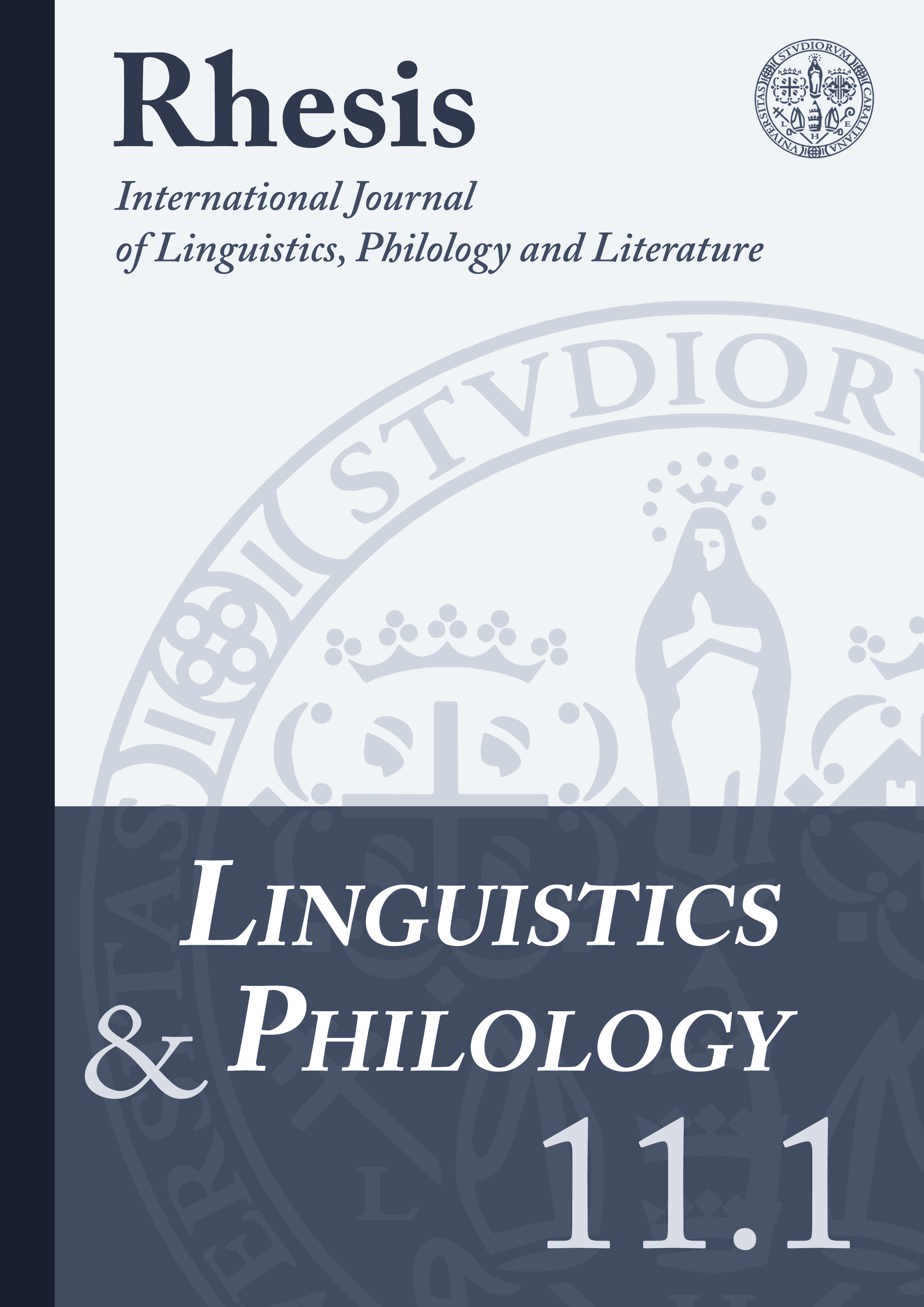Manipolazioni dei fatti nel racconto della battaglia contro i Nervi (Caes. BGall. II 15-28): un’analisi retorica
Abstract
Manipulations and alterations of facts are embedded in the artful narrative of Julius Caesar’s de bello Gallico. The modifications of reality are developed according to the author’s self-praising and apologetic aim. The stylistic organisation supports such alterations through an artful use of syntactic dispositions, figures of speech, sound figures and rhetorical instruments. This paper analyses the author’s manipulations in his account of the expedition against the Nervi (BGall. II 15-28). This section results deeply altered to make Caesar appear in a favourable way in the eyes of the reader. A close reading and a rhetorical analysis of chapters 18-25 show the narrative strategies and rhetorical instruments Caesar employed to alter the account of events. The investigation of the ethnographical digression (II 15) shows how the military skills of the Nervi are exaggerated to provide a justification for the difficulties faced during the battle; the amplification of the risks caused by the forests and the fortifications in the battlefield (II 16-17) goes in the same direction. An inter- and intra-textual analysis finally reveals how the account of the fight (II 19-28) is built up according to Caesar’s self-aggrandising aim.
Downloads
References
Brown, Robert D. (1999), ‘Two Caesarian Battle-Descriptions: A Study in Contrast’, The Classical Journal 98, 329-357.
Chausserie-Laprée, Jean-Pierre (1969), L’expression narrative chez les historiens latins, Paris, Éditions de Boccard.
Cipriani, Giovanni (1994), Cesare: la disfatta della Gallia (De Bello Gallico, VII), Venezia, Marsilio.
Cipriani, Giovanni; Masselli, Grazia Maria (2006), ‘Introduzione’, in Montanari, Lorenzo, Cesare. La Guerra Gallica, Siena, Barbera, V-CXI.
Cipriani, Giovanni; Masselli, Grazia Maria (2008), ‘Introduzione’, in Montanari, Lorenzo, Cesare. La Guerra Civile, Siena, Barbera, V-CLXX.
Collins, John H. (1952), Propaganda, Ethics, and Psychological Assumptions in Caesar’s Writings, Universität Frankfurt am Main, PhD dissertation.
Gärtner, Hans A. (1975), Beobachtungen zu Bauelementen in der antiken Historiographie besonders bei Livius und Caesar, Wiesbaden, Steiner.
Gotoff, Harold C. (1984), ‘Towards a Practical Criticism of Caesar’s Prose Style’, Illinois Classical Studies 9, 1-18.
Görler, Woldemar (1977), ‘Ein Darstellungsprinzip Caesars zur Technik der Peripetie und ihrer Vorbereitung im Bellum Gallicum’, Hermes 105, 307-331.
Grillo, Luca; Krebs, Christopher B. (eds.) (2018), The Cambridge Companion to the Writings of Julius Caesar, Cambridge, Cambridge University Press.
Hachmann, Rolf (1975), ‘Germains, Celtes et Belges dans la France du nord et en Belgique a l’époque de Jules César’, Revue archéologique n.s. 1, 166-176.
Hering, Wolfgang (1987), C. Iulii Caesaris Commentarii Rerum Gestarum: Bellum Gallicum, Lipsiae, B. G. Teubneri.
Kohns, Hans P. (1969), ‘Der Verlauf der Nervierschlacht’, Gymnasium 76, 1-17.
Kraner, Friedrich; Dittenberger, Wilhelm; Meusel, Heinrich (191317) [1853], C. Iulii Caesaris Commentarii De Bello Gallico, Berolini, Weidmann.
Krebs, Christopher B. (2006), ‘“Imaginary Geography” in Caesar’s Bellum Gallicum’, American Journal of Philology 127, 111-136.
Lausberg, Heinrich (1998) [1960], Handbook of Literary Rhetoric, Leiden-Boston-Köln, Brill.
Nousek, Debra L. (2004), Narrative Style and Genre in Caesar’s Bellum Gallicum, The State University of New Jersey, PhD dissertation.
Pascucci, Giovanni (1956), ‘I mezzi espressivi e stilistici di Cesare nel processo di deformazione storica dei Commentari’, Studi Classici e Orientali 6, 134-174.
Pelling, Christopher (2009), ‘Seeing through Caesar’s Eyes: Focalisation and Interpretation’, in Grethlein, Jonas; Rengakos, Antonios (eds.), Narratology and Interpretation: The Content of Narrative Form in Ancient Literature, Berlin-New York, de Gruyter, 507-526.
Pelling, Christopher (2013), ‘Xenophon’s and Caesar’s third-person narratives – or are they?’, in Marmodoro, Anna; Hill, Jonathan (eds.), The Author’s voice in Classical and Late Antiquity, Oxford, Oxford University Press, 39-76.
Pelling, Christopher; Wyke, Maria (2014), Twelve Voices from Greece and Rome: Ancient Ideas for Modern Times, Oxford, Oxford University Press.
Pennacini, Adriano (1996), Gaio Giulio Cesare. La guerra gallica, Torino, Einaudi.
Pinkster, Harm (1992), ‘The Latin Impersonal Passive’, Mnemosyne 45, 159-177.
Rambaud, Michel (1953), L’art de la déformation historique dans les Commentaires de César, Paris, Les Belles Lettres.
Raspë, Pascal (2013), ‘Remarques sur la localisation de l’oppidum des Aduatiques à Thuin’, Ollodagos 29, 261-265.
Schadee, Hester (2008), ‘Caesar’s Construction of Northern Europe: Inquiry, Contact and Corruption in De Bello Gallico’, The Classical Quarterly 58, 158-180.
Stevens, Courtenay E. (1952), ‘The Bellum Gallicum as a Work of Propaganda’, Latomus 11 (2), 165-179.
TLL = Thesaurus linguae Latinae, Lipsiae, B. G. Teubneri, Berlin-Boston, de Gruyter, 1900-2017.
Torrego, Maria E. (2002), ‘Statim, paulatim, repente/subito: Scope and Lexical Aspect’, in Bolkestein, Alide M.; Kroon, Caroline H.M.; Pinkster, Harm; Remmelink, Hendrik W.; Risselada, Rodie (eds.), Theory and Description in Latin Linguistics. Selected Papers from the XIth International Colloquium on Latin Linguistics, Amsterdam June 24-29, 2001, Amsterdam, Gieben, 379-392.
Welch, Kathryn; Powell, Anton (eds.) (1998), Julius Caesar as Artful Reporter. The War Commentaries as Political Instruments, Swansea, Classical Press of Wales.
Zecchini, Giuseppe (1978), Cassio Dione e la Guerra Gallica di Cesare, Milano, Vita e Pensiero.
Zecchini, Giuseppe (2002), Vercingetorige, Roma-Bari, Laterza.



